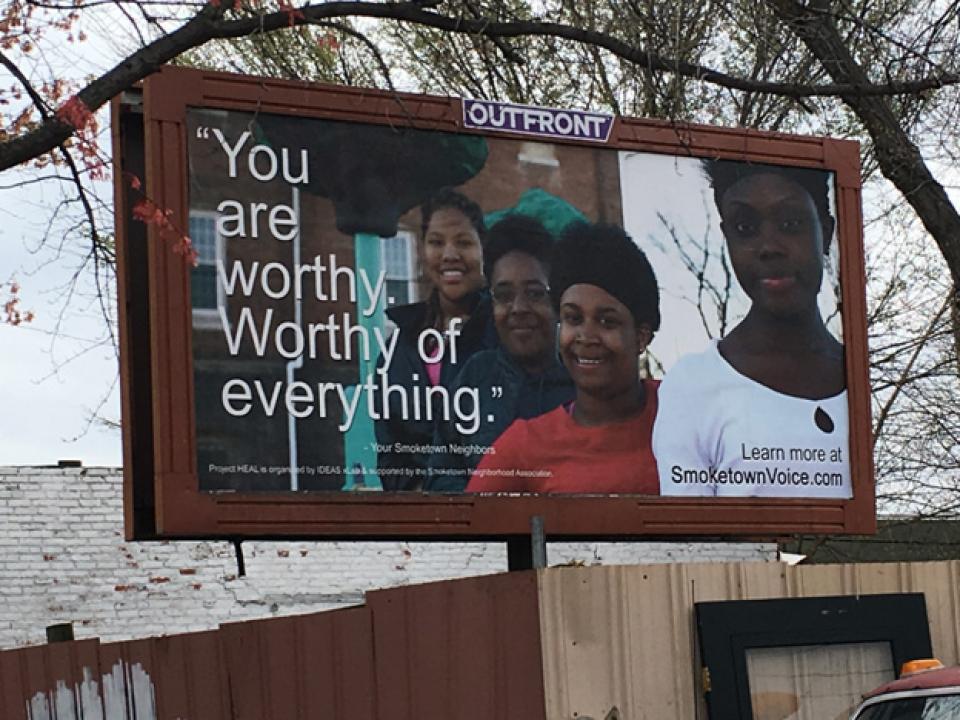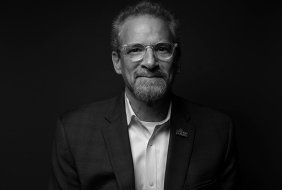I recently drove to Louisville to visit a dynamic organization named IDEAS xLab that joined us as one of seven communities nationally in winning the Culture of Health Prize from the Robert Wood Johnson Foundation in 2016. Their work uses the arts in community building in a way that would be wonderful to replicate through Beyond Housing – but more about them in moment. The roundtrip drive to Louisville from St. Louis takes about eight hours, so there’s plenty of time to notice the signs along the way. On the ride home westbound on Hwy.64 somewhere in rural Indiana I drove past one of the blue highway signs that normally informs you about gas, food, attractions, or other important locations at the upcoming exit – but this blue sign was blank.
The blankness made me wonder. Did there used to be a gas station, a restaurant, or some other attraction here? What happened to whatever used to be there? How did the residents feel about the loss of whatever was on the blue sign? Once you have nothing on your blue sign, can you ever refill the sign with something new, or is your community now blankly labeled for good? Does the blue sign define your value as a place? All the questions made me think of the place I just left in Louisville and the place I work in St. Louis.
IDEAS xLab works in a part of Louisville called Smoketown located near downtown. Smoketown got its name from the kiln smoke where the the bricks that built much of Louisville were made – not unlike St. Louis. As you can imagine, Smoketown was not designed for the affluent but the African-American community in Louisville. As a team of 24:1 leaders walked through Smoketown, we all noted how similar it was to St. Louis and our 24:1 community. Pockets of rejuvenation and renewal next to areas of abandonment and decay. Modest housing with great usability features for families. Resilient and dynamic community folks unwilling to let their community fail. Caring public officials trying to bring resources to the community in the face of much resistance. Passion for real progress – but that passion was weighed down by too much work with far too few tools to truly make a real dent in the need. We might be tempted to make the comparison between Smoketown and that blank blue highway sign, but that’s actually far from the truth.
When asked where to get the best local meal, we were sent to Shirley Mae’s Café in Smoketown. In business for more than 40 years, Shirley Mae and her staff have seen many changes, but they remain a constant in the heartbeat of Smoketown. Ms. Dee welcomed us with her Southern charm as she obviously recognized that we were tourists. For the first ten minutes we were delighted by the humor of Ms. Dee, who nicely poked fun at all of us in some form or fashion. She clearly has been doing this for some time, and we were far from the first tourists to see the inside of Shirley Mae’s. After we placed our drink orders of sweet tea, red kool-aid, and freshly squeezed lemonade along with our food orders of Southern specialties including fried pork chops, tilapia, collard greens, hot water cornbread, fried corn, sweet potatoes, mac and cheese, and more, Ms. Dee sat down with us for a visit.
As I talked with Ms. Dee and her comedy act slowly started to fade a bit, it was clear she loved her community and was passionate about its future. Ms. Dee was incredibly well read, bouncing from the history of the Freedom Railroad in Louisville to the Middle East with ease. She talked about demanding respect from those who came in Shirley Mae’s and giving it back in return. She also spoke of her restaurant paying for a carnival in the neighborhood every year, which always included bringing in celebrities such as Morgan Freeman and Whoopi Goldberg to show Smoketown how important it was and to encourage the people to keep fighting for their future. While others may see a blank sign in Smoketown, Shirley Mae’s Cafe and Ms. Dee see a sign filled with all kind of neighborhood assets, especially fried pork chops!
After lunch we happily went on a Historical Poetry Walk seeing the landmarks in Smoketown. IDEAS xLab choreographed the walk that including seeing a number of new billboards that featured community residents with a series of positive messages such as this one:
These wonderful visuals and messages replaced all the negative, predatory billboards that dot the landscape of many of our communities. The walk ended at the Smoketown Unity Monument, a pair of boxing gloves displayed as an homage to hometown hero Muhammad Ali.
At the Unity Monument IDEAS xLab presented Smoketown dialogues that featured stories of challenge and triumph inspired by and featuring community members. It was indeed powerful, and after seeing it, no one could say that the sign leading to Smoketown was empty.
The Smoketown visit also reminded me about a recent meeting in 24:1 with more than two dozen Wellston residents. Most in attendance were gray around the temples but still ever passionate to be a Wellstonian. This community that once was a thriving neighborhood with a bustling “loop” full of business and blocks full of well-maintained homes was now struggling. Their struggles did not dampen their enthusiasm about what the future could hold for them. Ms. Helen Jackson repeatedly reminded all in attendance to keep fighting, keep pushing their elected officials to do more, and keep encouraging them to roll up their sleeves and be a part of the solution. At one point, Ms. Jackson looked at me and said, “Chris, you know me and you are OK, and Beyond Housing is doing their part.” I so appreciated that, because what Ms. Jackson was doing was affirming our role as a partner and not the leader – it is the residents who are the leaders. Just as with Smoketown, the sign leading to Wellston is not blank. It is full of the energy and commitment of all those in attendance with their unwavering commitment to make Wellston a better place.




